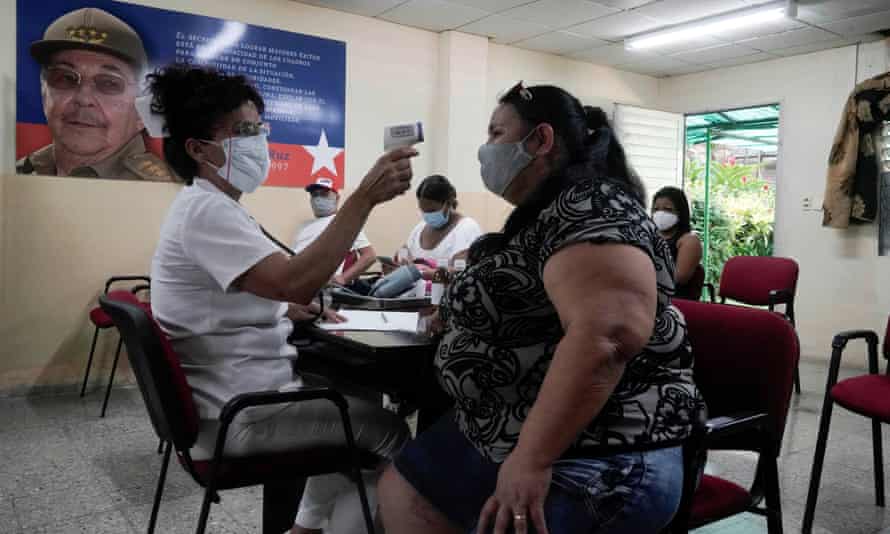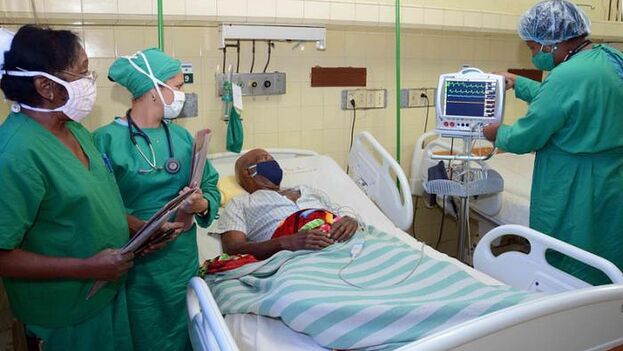A lack of medical supplies is crippling the Covid response, amid an economic crisis sparked by the pandemic and US sanctions

Ed Augustin and Daniel Montero in Havana
Sun 22 Aug 2021
Julia, a community doctor in Havana, was drafted to the intensive care unit soon after Covid-19 first reached Cuba.
Last week, her cousin died from the virus. This week, she also tested positive amid a surge in cases which has pushed the island’s vaunted health service to its limits and prompted rare public criticism from Cuban doctors.
“It hurts to see people die from this terrible virus,” she said, recovering at home from nausea after being injected with an immune booster. “The mood among doctors gets worse by the day.”
After recording one of the world’s lowest Covid rates last year, Cuba now has one of the western hemisphere’s highest. The island, which reported 12,225 confirmed cases in all of 2020, has reported almost 50 times that so far this year. And as the Delta variant spreads, a lack of medical supplies is crippling the medical response.
“There are no antibiotics, no painkillers, the basic list of medicines is almost all out of stock,” said Daniela, a family doctor in Havana who has hardly had a day off since the pandemic began.
In the face of extreme scarcity, doctors are increasingly prescribing herbal remedies. Mortuaries are overwhelmed. The country’s main oxygen factory recently broke down, compounding the intensive care crisis.
Cuba last year hospitalised everybody who tested positive for Covid, including asymptomatic cases. But even for a country with the world’s highest doctor-to-patient ratio, average daily case loads of 9,000 have made that protocol unworkable. Now children, the elderly, pregnant women and severe cases are hospitalised, while others must isolate at home.
Hundreds of doctors have been brought back from international “missions” abroad – a major hard currency generator for the state – to support exhausted colleagues. But the move has not been enough to stop the system, which last year was a model of test, track and isolate, from fraying.
“I was at home for eight days and nobody came to see me,” said Oscar, a hotel worker from Cienfuegos who came down with Covid last month.
The pandemic, which eliminated tourism, and US sanctions have knocked billions of dollars from state coffers, creating a dire economic crisis and contributing to unprecedented political unrest on the island. Strapped for cash, Cuba’s public health system has been forced to perform triage: focusing on expensive vaccine production at the expense of other medical supplies.
The prime minister, Manuel Marrero, last week recognised the depth of the crisis in uncharacteristically forthright language.
Provinces “lack antigen tests [and] medicines”, he told party officials in Cienfuegos. “But there are more complaints about subjective problems than objective problems. When you add up the [complaints about] lack of medicines, they are less than the number of complaints about mistreatment, lack of care, and home visits.”
His comments provoked outcry on social media, and 23 doctors in the eastern province of Holguin posted a video rebuttal on Facebook.
“We want to keep saving lives,” said Dr Daily Almaguer, a heart specialist, in the video. “We are not the ones responsible for our country’s healthcare collapse.”
The doctors have since been summoned by authorities.
The spike, unimaginable last year, comes as Cuban scientists race to achieve immunity through vaccination. Cuba is the smallest country in the world to have developed its own Covid vaccines. Both Soberana 2 and Abdala have an efficacy rate of more than 90%, according to clinical trials.
But US sanctions – supercharged by Trump, left in place by Biden – have slowed rollout.

Since the outgoing Trump administration designated Cuba as a “state sponsor of terrorism”, firms have taken fright and just a handful of banks in the world will now transfer funds from Cuban entities, complicating imports.
Cuban scientists say industrial scale production of Soberana 2 was stalled for weeks as they could not source an essential component.
“The lack of one small ingredient or one small control item can really throw production off,” said Gail Reed, executive editor of Medicc Review, a peer-reviewed health journal.
Advertisement
“US sanctions have had a nefarious, even lethal, effect on Cuba’s ability to face down the latest surge.”
Though slow out of the starting blocks, Cuba now has the third highest vaccination rate in Latin America (behind Chile and Uruguay). Twenty-seven per cent of the population have now been fully vaccinated, and 44% have received at least one dose.
Come September, scientists say, the island will have produced enough doses to vaccinate the whole population.
“We remain in combat against the pandemic,” said Dr Gerardo Guillén, Abdala’s lead developer. “The vaccines are working, as the data is now showing,” he added, referring to falling infection and mortality rates in Havana, where the mass vaccination campaign began.
Until millions more are fully vaccinated, the country’s exhausted army of underpaid doctors must trudge on.
“We are doing the impossible,” said Julia, the community doctor still mourning the death of her cousin. “Despite the lack of medicines, gloves and oxygen, doctors are fighting to save lives. They really are heroes.”
A Very Sad Night in Cienfuegos, Cuba
“Last night 36 patients died in a Cienfuegos Hospital” laments a Cuban Doctor

HAVANA TIMES – “The Cienfuegos hospital continues to have an oxygen deficit. The helicopters of the Primetime News on Cuban Television are something symbolic for the need that exists,” a doctor from the province, which has replaced Ciego de Ávila as the province with the highest positive rate of covid on the island, tells this newspaper.
“In recent days 32, 34 patients have died. Last night (August 17th) 36 patients died, of which only 4 had a positive PCR at the time of death. They are the only ones registered as dead by coronavirus, but in reality, the other 32 were post-covid patients and they don’t count them,” says the source.
The doctor adds that in the province there are normally one or two deaths of pregnant women a year, but in the last four days there has been a daily death. “That gives an idea of the crisis we are experiencing,” he explains, while reproaching the government for trying to pretend to have everything under control, making it difficult for humanitarian aid to arrive.
However, the provincial press continues to move the pieces. A few days ago, the Ciego de Ávila newspaper confirmed the lack of oxygen and the precarious situation in the area, and now it is September 5, the official Cienfuegos newspaper, which speaks of an “unprecedented scenario” in an article titled Covid-19 in Cienfuegos: The truth on the Table.
The newspaper denounces the fact that diagnostic tests are lacking, PCRs pile up without results, there is poor management of cases in primary care according to their risk, and that people end up in serious condition in hospitals due to the lack of screening. Added to this is the lack of medicinal oxygen — despite the incorporation of the Armed Forces and Russia into production — and the shortage of medicines and medical supplies.
To all this is added, the newspaper continues, that what the Government promised does not always arrive. “I must tell you that there are problems with food, that in not a few cases breakfast has been eaten late and lunch appears in the afternoon. It also happens that after discharge people have to wait up to three and four hours for transportation,” denounces a citizen.
September 5 also addresses one of the most serious problems, the lack of healthcare personnel. According to the newspaper, of the 701 doctors in the province, 446 are working. Most of those absent are in the care of children and relatives, but many others have tested positive for covid-19.
“There are reports of low medical coverage in isolation centers, this affects the quality of care for patients and represents an overload for the healthcare personnel who work in these spaces (…) In a visit to the Carlos Roloff vocational pre-university, in Cumanayagua, there were 250 people admitted and there were only two doctors to attend that universe,” details Félix Duarte Ortega, of the Central Committee of the Communist Party of Cuba (PCC).
The newspaper reports that the “political authorities of Cienfuegos recognized the effort of those who work in hospitals and isolation centers, in clinics and polyclinics. Those who do not give up despite the thousand and one difficulties that are experienced today.” The strategy is part of the pro-government dynamic of recent days, which tries to soften the conflict created by Prime Minister Manuel Marrero when he blamed doctors, specifically from Cienfuegos, for the violations of protocols that promote the spread of covid-19.
The rebellion of the doctors has grown since that day, both among the usual critics of the regime and in those who believe in it but watched the spectacle of being blamed for managing the disease when they must fight in the front line against it devoid of resources, and in a framework of war medicine.
“The medical personnel exist and are sacrificing themselves, what does not exist are the means. Many of us believe that they are subjecting us to genocide. While the people die they are watching the doctors to see what they say, if they are in favor or not of the Revolution,” denounces the doctor from Cienfuegos.
President Miguel Diaz-Canel has been tweeting praises to healthcare personnel for three days in an attempt to redirect the situation. Last Sunday, when the clamor of the health workers spread through the networks calling for the resignation of Marrero, he said, with little luck: “Today the groups in which we go through life are more visible, according to José Martí: On the one hand those who love and create. And on the other, those who hate and destroy. The former do not lie or slander or defame, they do not hate. They are saving lives. The others cannot with that light.”
A day later, he rectified the divisive message with another that only had a positive tone: “What we have seen the most in this time is the patriotism of our people, the Healthcare personnel, the scientists, of all those involved in the millimeter-level oxygen operation, people who are working full time in complex situations. Thank you all! ” That same day, the official press vindicated the doctors with an article titled At the foot of the patient, the hero who does not serve enemy campaigns, which once again separated the like-minded from the critics.
Yesterday, Tuesday, the campaign continued, with an image on the cover with the faces of doctors and nurses in the article entitled Let’s think about them and take care of ourselves. “Gratitude for the titanic feat assumed by our Health workers in this battle against covid-19 also requires, now more than ever, our responsibility,” says the official newspaper, on this occasion, taking care to refer to the ’rebels.’
Ernesto Haber Santos, a doctor at the Saturnino Lora Hospital in Santiago de Cuba, has rejected, through Facebook, the government’s campaign called Put your heart in it, with a view to once again winning the favor of his star workers for decades.
“We work with the little we have and the hardest we can. Tired, leaving our family and putting it at risk. But one is not willing to publicly assume reality, it is better to look for a scapegoat, and from what I see, everyone is a candidate. We have plenty of heart, we are giving our all ,and at the rate we are going we will have to continue until who knows when,” he said.
The doctor asks the Government to accept that the situation has reached the limit and to accept help. “The covid-19 overcame us, overcame the United States, Spain and many others,” claims the doctor, who asks the authorities to rectify and recognize the excellence of the country’s health workers or, on the contrary, say they are graduating untrained people and that “the pride in being a medical power is a delusion.”










